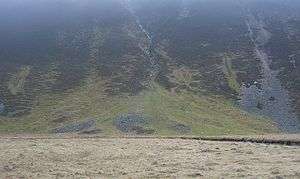Debris cone

A debris cone consists of debris deposited in a conical shape with a surface slope greater than 10 degrees (perpendicular to contours), usually transported by small streams or snow avalanches.
A debris cone is commonly made when rock from a high-up narrow slit or gorge falls into a flat-floored valley. Here the soil and loose materials are deposited, leaving a mound of conical shape. While an alluvial fan is formed when flowing water rushes rock and soil down a slope, debris cones come from one of several dry processes known as mass wasting. That is gravity pulling loose materials downslope. Such mounds can reach sizes large enough to obstruct river channels. Similar deposits can also be found lying on boulders moved by a landslide, or on a glacier, where a cone-shaped mound of ice or snow may be covered with a veneer of debris thick enough to prevent the underlying ice from melting. A debris cone is also called a dirt cone or cone of detritus.[2]
See also
References
- ↑ Webb, Richard. "Debris Cone". Photograph. Retrieved 11/10/12. Check date values in:
|access-date=(help) - ↑ Chang, Lan Samantha. "Debris Cone". Trinity University Press. Archived from the original on 2013-10-29. Retrieved 11/10/12. Check date values in:
|access-date=(help)